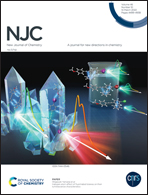Facile design of a WO3 nanorod-decorated graphene oxide 1D–2D nanocatalyst for the synthesis of quinoline and its derivatives†
Abstract
Developing highly efficient, robust, and recyclable catalysts with convenient product separation is a major challenge in the catalytic production of fine chemicals. One dimensional nanostructures and their uniform decoration on a suitable support material could result in the generation of a potential heterogeneous catalyst that addresses these issues. With this in mind, herein, the hydrothermal preparation and catalytic evaluation of GO decorated with WO3 nanorods (GO–WO3) is demonstrated as a suitable heterogeneous catalyst for the synthesis of fine chemicals. These synthesized nanocatalysts were thoroughly characterized using various analytical techniques such as X-ray diffraction (XRD), Fourier-transform infrared (FTIR) spectroscopy, Raman spectroscopy, field emission scanning emission microscopy (FESEM), energy dispersive X-ray (EDX) analysis, high-resolution transmission electron microscopy (HRTEM), N2 adsorption–desorption measurements, ammonia temperature programmed desorption analysis (NH3-TPD), pyridine adsorbed FT-IR spectroscopy, cyclic voltammetry (CV) and X-ray photoelectron spectroscopy (XPS). The FESEM and HRTEM images showed well-distributed WO3 nanorods (diameter = 20–30 nm and length = 100–150 nm) on the GO surface and the XPS results revealed the hexadented state of tungsten. The total amount of acidic sites present in the catalyst was calculated from the NH3-TPD and found to be 1.752 mmol g−1. The CV results show the electronic interaction in the nanocomposite. The cathodic and anodic peaks for WO3 were found to be located at 0.11 and 0.62 V and for GO–WO3 at 0.17 and 0.54 V, respectively. The high catalytic activity of GO–WO3 is a result of the acidic nature and the appropriate electronic interaction between the GO and WO3 nanorods. Moreover, the reaction conditions were optimized by varying different parameters, such as the catalytic dose (20 wt% of WO3 loaded to GO), solvent, catalytic loading, and temperature. The GO–WO3 nanocatalyst could be recycled for up to five continuous cycles with a minimum loss of activity.



 Please wait while we load your content...
Please wait while we load your content...